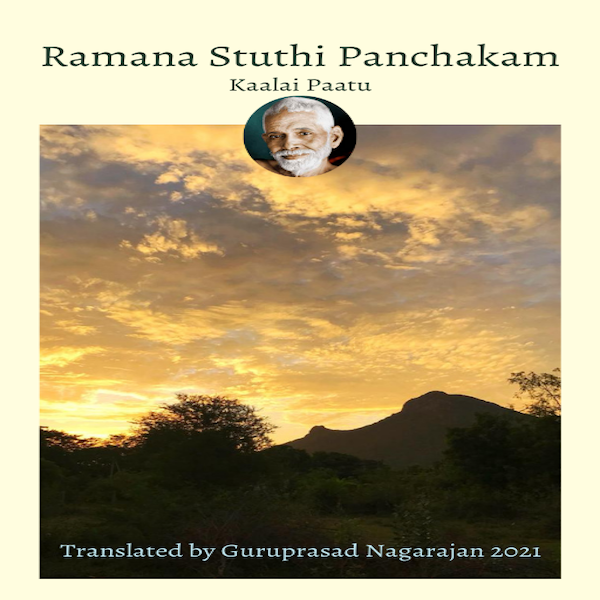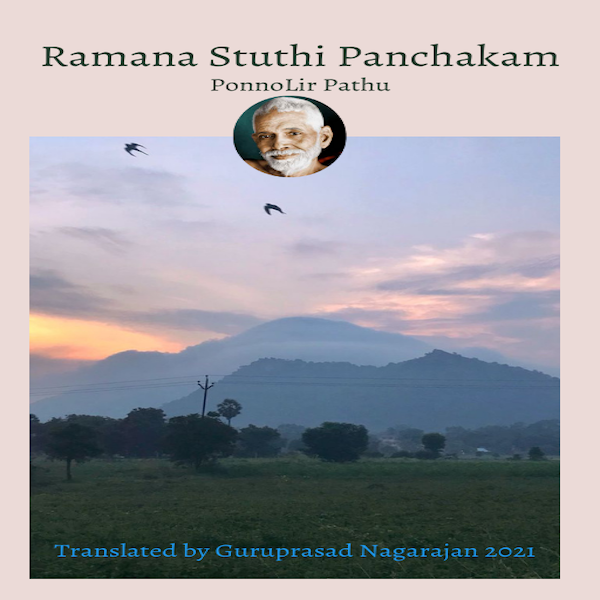Nindridun choNa saila nilaithidum ramaNan vaazhi
Mindigazh sadayanodu virupaksha gugayum vaazhi
Vendridum thunbam poka vengada ramaNan sollum
Pondrigazh virutha malai polivura vaazhi vaazhi
Word meaning
Nindridum = that which is standing; choNa/soNa = golden; nilaithu = established; vaazhi = long live; mindigazh (min thigazh) = like lightning; vendridum = that which will win/conquer; thunbam = sorrow; pondrigazh (pon thigazh) = like gold; polivu = brightness, lustre; virutham = type of poem.
Meaning
Long live Ramana Bhagavan who is established in the ever-famous Arunachala! Long live the lord (Ramana) who shines bright as a streak of lightning! Long live Virupaksha Cave! Long live this poem written by me, named Venkataraman, to dispel the sorrows of devotees!
SV equates Bhagavan with Lord Shiva again as ‘mindrigazh sadayan’ meaning the matted-haired one who shines with the brightness of lightning strike. Usually ‘sadayan’ is used to describe Shiva, especially ‘thaazh sadayan’ meaning the one withe matted locks that hanging down’. As we observe, through this work of five poems, SV has made no distinction between Bhagavan and Lord Shiva.
Nindridum soNa salami here means Arunachala the holy hill that is permanently established. The hill was pillar of fire in Satya Yuga and has transformed to what it is now, a seemingly ordinary hill, in this Kali Yuga. We can take it to mean that Arunachala is a constant through the ages and millennia. Since this is the last verse, it is a call to the longevity of the subject of the song, which is Bhagavan, itself, and those who read and recite it, the devotees.
Long live Bhagavan (as Arunachala), long live Virupaksha Cave, long live the devotees for whose sorrow-eradication this is composed, and long live Ponnolir Pathu.
NOTE: This poem is composed in the ‘andhadhi’ format where the first word of the subsequent stanza takes off from the last word of the previous stanza. ‘Andhadhi’ is split as ‘andham’ meaning end and ‘aadhi’ meaning beginning.
Mindigazh sadayanodu virupaksha gugayum vaazhi
Vendridum thunbam poka vengada ramaNan sollum
Pondrigazh virutha malai polivura vaazhi vaazhi
Word meaning
Nindridum = that which is standing; choNa/soNa = golden; nilaithu = established; vaazhi = long live; mindigazh (min thigazh) = like lightning; vendridum = that which will win/conquer; thunbam = sorrow; pondrigazh (pon thigazh) = like gold; polivu = brightness, lustre; virutham = type of poem.
Meaning
Long live Ramana Bhagavan who is established in the ever-famous Arunachala! Long live the lord (Ramana) who shines bright as a streak of lightning! Long live Virupaksha Cave! Long live this poem written by me, named Venkataraman, to dispel the sorrows of devotees!
SV equates Bhagavan with Lord Shiva again as ‘mindrigazh sadayan’ meaning the matted-haired one who shines with the brightness of lightning strike. Usually ‘sadayan’ is used to describe Shiva, especially ‘thaazh sadayan’ meaning the one withe matted locks that hanging down’. As we observe, through this work of five poems, SV has made no distinction between Bhagavan and Lord Shiva.
Nindridum soNa salami here means Arunachala the holy hill that is permanently established. The hill was pillar of fire in Satya Yuga and has transformed to what it is now, a seemingly ordinary hill, in this Kali Yuga. We can take it to mean that Arunachala is a constant through the ages and millennia. Since this is the last verse, it is a call to the longevity of the subject of the song, which is Bhagavan, itself, and those who read and recite it, the devotees.
Long live Bhagavan (as Arunachala), long live Virupaksha Cave, long live the devotees for whose sorrow-eradication this is composed, and long live Ponnolir Pathu.
NOTE: This poem is composed in the ‘andhadhi’ format where the first word of the subsequent stanza takes off from the last word of the previous stanza. ‘Andhadhi’ is split as ‘andham’ meaning end and ‘aadhi’ meaning beginning.







 RSS Feed
RSS Feed